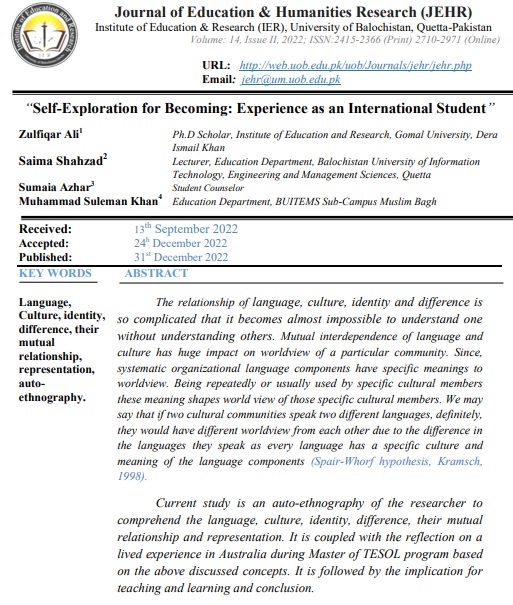Self-Exploration for Becoming: Experience as an International Student
Language, Culture, identity, difference, their mutual relationship, representation, auto-ethnography
Abstract
The relationship of language, culture, identity and difference is so complicated that it becomes almost impossible to understand one without understanding others. Mutual interdependence of language and culture has huge impact on worldview of a particular community. Since, systematic organizational language components have specific meanings to worldview. Being repeatedly or usually used by specific cultural members these meaning shapes world view of those specific cultural members. We may say that if two cultural communities speak two different languages, definitely, they would have different worldview from each other due to the difference in the languages they speak as every language has a specific culture and meaning of the language components (Spair-Whorf hypothesis, Kramsch, 1998).
The current study is an auto-ethnography of the researcher to comprehend the language, culture, identity, difference, mutual relationship, and representation. It is coupled with the reflection on a lived experience in Australia during the Master of TESOL program based on the above-discussed concepts. It is followed by the implication for teaching and learning and the conclusion.
References
Berry, K. (2011). The ethnographic choice: Why ethnographers do ethnography. Cultural Studies ↔ Critical Methodologies, 11(2), 165-177. https://doi.org/10.1177/1532708611401335
Bright, D. (2017). Recognizing students and teachers: difference and identity in international classrooms. Critical Studies in Education, 1-13. doi:10.1080/17508487.2017.1327448
Coulter, C., & Jimenez-Silva, M. (2017). Conclusion: a hopeful imperative. In Culturally sustaining and revitalizing pedagogies: language, culture, and power [Pdf] (29th ed., pp. 289-292). Retrieved from https://www-emeraldinsight-com.ezproxy.lib.monash.edu.au/doi/pdfplus/10.1108/S1479-368720150000029022
Crowther, D., & Costa, P. D. (2017). Developing mutual intelligibility and conviviality in the 21st century classroom: insights from English as a lingua franca and intercultural communication. TESOL Quarterly teaching issues, 51(2), 450-460. Retrieved from https://onlinelibrary-wiley-com.ezproxy.lib.monash.edu.au/doi/epdf/10.1002/tesq.341
Denzin, N. K. (2006). Analytic Autoethnography, or deja Vu all over again. Journal of Contemporary Ethnography, 35(4), 419-428. https://doi.org/10.1177/0891241606286985
Eid, M. (2014). Perceptions about Muslims in Western Societies. In M. Eid & K. H. Karim (Eds.), Re-imagining the other [Pdf] (1st ed., pp. 99-121). Retrieved from https://www.researchgate.net/publication/304860739_Perceptions_about_Muslims_in_Western_Societies
Hall, S. (2013). The work of representation. In Representation [Pdf] (2nd ed., pp. 1-47). Retrieved from https://content.talisaspire.com/monash/bundles/5a937cef646be044b15149d4
Hall, S., & Kelly, J. (2013). A sociocultural perspective on language and culture. In Teaching and researching language and culture (2nd ed., pp. 5-29). Oxford shire, England: Routledge.
Holt, N. L. (2003). undefined. International Journal of Qualitative Methods, 2(1), 18-28. https://doi.org/10.1177/160940690300200102
Jaskulska, M., & Łockiewicz, M. (2017). Polish as L1, English as L2: the linguistic transfer impact on second language acquisition stemming from the interlingual differences: implications for young learners education. Issues in early education, 2(37), 68-76. Retrieved from cejsh.icm.edu.pl/cejsh/element/...647d.../Martyna_Jaskulska__Marta_Lockiewicz.pdfhttps://www.google.com.au/search?q=L1+has+influnence+on+L2+learning.+PDF+AND+2014%2C+2015%2C+2016%2C+2017%2C+2018&oq=L1+has+influnence+on+L2+learning.+PDF+AND+2014%2C+2015%2C+2016%2C+2017%2C+2018&aqs=chrome..69i57.28495j0j7&sourceid=chrome&ie=UTF-8
Kramsch, C. (1998). The relationship of language and culture. In C. J. Kramsch (Ed.), Language and culture (pp. 3-14). New York, NE: Oxford University Press.
Lee, A. (2015, January 18). [Documentary] Stuart Hall's Encoding Decoding [Video file]. Retrieved from https://www.youtube.com/watch?v=e9z7R71f2wY
Michelson, K. (2018). Teaching culture as a relational process through a multiliteracies-based global simulation. Language, Culture and Curriculum, 31(1), 1-20. Retrieved from https://www-tandfonline-com.ezproxy.lib.monash.edu.au/doi/pdf/10.1080/07908318.2017.1338295?needAccess=true
Morgan, B. (2007). Poststructuralism and applied linguistics. In J. Cummins & C. Davison (Eds.), International handbook of English language teaching [chapter 63] [Pdf] (pp. 1033-1052). Retrieved from https://link-springer-com.ezproxy.lib.monash.edu.au/chapter/10.1007%2F978-0-387-46301-8_69#enumeration
Murdock, E. (2016). Final conclusions. In Multiculturalism, identity and difference [Pdf] (pp. 317-336). Retrieved from https://link-springer-com.ezproxy.lib.monash.edu.au/content/pdf/10.1057%2F978-1-137-59679-6_7.pdf
Odn. (2017, August 17). Anti-Muslim senator sparks anger by wearing burqa [Video file]. Retrieved from https://www.youtube.com/watch?v=1TtOw87_xD8
Solé, R. V., Murtra, B. C., Valverde, S., & Steels, L. (2010). Language networks: their structure, function and evolution. Complexity, 15(6), 20-26. Retrieved from https://doi.org/10.1002/cplx.20305
Woodward, K. (1997). Introduction [chapter 1]. In Identity and difference (pp. 8-12). Thousand Oaks, CA: Sage in association with Open University.




